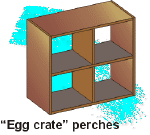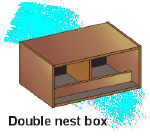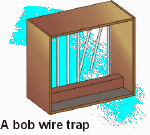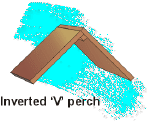Before Christmas, we looked
briefly at pigeons and what makes them special. In the next series of articles, we will
explore the requirements for keeping and breeding pigeons successfully. This episode looks
at pigeon housing.
Pigeons don't need ostentatious abodes, after all they have been living quite happily
for centuries in cliffs and on boring park statues. Pigeon houses can range from
old-fashioned dovecotes, (those funny looking little houses high up on poles) to
multi-storey lofts, with a myriad of variations in between. Pigeon houses can be called
coops, pens or lofts, depending on what kind of pigeons you decide to raise. Most pigeons
would be quite happy in a cote, however for all purposes of good husbandry, these are not
practical so we won't bother delving any deeper into those. So, what's the difference
between the others, I hear you ask? A pen is used to house utility pigeons (the big meaty
ones) like Carneaux, Kings or Runts. Fancy pigeons are kept in coops and racing and flying
pigeons belong in a loft. Simple, huh? I personally call them all 'lofts', but whatever
YOU decide to call it, the cage you build for your pigeons must fulfil a number of pigeon
requirements.
 Pigeons know what they need to be happy... well they
ARE pigeons, so when you plan the loft they are to live in, be sympathetic to their needs.
Racing pigeons will need a loft without a wire flying area, after all, the main purpose of
a racing pigeon is to be out racing and when not doing that, inside breeding and raising
baby racing pigeons. Similarly, flight pigeons such as Tipplers, Rollers and Flying
Tumblers will need the same kind of house, as they will be spending a lot of time outside
flying free too. Both racing and flying pigeon lofts need landing boards and bob-wire
traps to get the birds back inside. These are hinged wires which open inwards when the
birds push against them, but don't allow the birds to push their way out again. Fancy
pigeons like Fantails, Pouters and the like will need a wired flight area where they can
sun themselves as they will not usually be allowed outside the loft. Their loft will also
need lots of walking areas, where they can strut and show off. The perches will be quite
low to the floor as these types of birds aren't expected to fly all that much (some show
pigeons are actually ruined for exhibition if they fly). And finally, meat breeds will
need lots of open floor spaces with low-set perches and nesting areas.
Pigeons know what they need to be happy... well they
ARE pigeons, so when you plan the loft they are to live in, be sympathetic to their needs.
Racing pigeons will need a loft without a wire flying area, after all, the main purpose of
a racing pigeon is to be out racing and when not doing that, inside breeding and raising
baby racing pigeons. Similarly, flight pigeons such as Tipplers, Rollers and Flying
Tumblers will need the same kind of house, as they will be spending a lot of time outside
flying free too. Both racing and flying pigeon lofts need landing boards and bob-wire
traps to get the birds back inside. These are hinged wires which open inwards when the
birds push against them, but don't allow the birds to push their way out again. Fancy
pigeons like Fantails, Pouters and the like will need a wired flight area where they can
sun themselves as they will not usually be allowed outside the loft. Their loft will also
need lots of walking areas, where they can strut and show off. The perches will be quite
low to the floor as these types of birds aren't expected to fly all that much (some show
pigeons are actually ruined for exhibition if they fly). And finally, meat breeds will
need lots of open floor spaces with low-set perches and nesting areas.
 Your pigeons will also spend a lot of time making and
raising babies, so they will need nest boxes to do it in. And seeing as how male pigeons
are one of nature's biggest show-offs, they will need more boxes than you might think.
Once a male pigeon claims a nest box and settles his wife in, he will most likely head off
to raid and steal the boxes of others. A good idea is to make the boxes in pairs, with a
running board that extends right in front of both compartments and a barrier between each
pair of boxes. Kind of like little bird-sized apartments! That way, if he heads off to
steal another box, one of his rivals will quickly step in to steal HIS box and possibly
his wife as well! Male pigeons catch on pretty fast though and it doesn't take long for
peace to reign. This show-off trait will probably also mean that you will need more than
one loft so the single males don't cause trouble for the paired birds. Next, let's think
about the size of the loft. Generally speaking, each breeding pair should have about four
square feet (a little over one square metre) of floor space. So a loft for 5 breeding
pairs will be about 20 square feet.
Your pigeons will also spend a lot of time making and
raising babies, so they will need nest boxes to do it in. And seeing as how male pigeons
are one of nature's biggest show-offs, they will need more boxes than you might think.
Once a male pigeon claims a nest box and settles his wife in, he will most likely head off
to raid and steal the boxes of others. A good idea is to make the boxes in pairs, with a
running board that extends right in front of both compartments and a barrier between each
pair of boxes. Kind of like little bird-sized apartments! That way, if he heads off to
steal another box, one of his rivals will quickly step in to steal HIS box and possibly
his wife as well! Male pigeons catch on pretty fast though and it doesn't take long for
peace to reign. This show-off trait will probably also mean that you will need more than
one loft so the single males don't cause trouble for the paired birds. Next, let's think
about the size of the loft. Generally speaking, each breeding pair should have about four
square feet (a little over one square metre) of floor space. So a loft for 5 breeding
pairs will be about 20 square feet.
 Once the needs of the birds have been considered, think of YOUR
needs! If you are a hefty six-footer, there isn't much sense in building a five-foot high
pigeon house. Pigeon keepers have to get into their lofts to feed and water the birds,
band the youngsters and catch those race winning champions as they dive through the
bob-wires. So it is most important that your own comfort is also considered. It is a good
idea when building the loft, that nest boxes, perches and other items are not made
permanent fixtures. You will most likely want to change things around inside the loft as
your own particular husbandry style develops.
Once the needs of the birds have been considered, think of YOUR
needs! If you are a hefty six-footer, there isn't much sense in building a five-foot high
pigeon house. Pigeon keepers have to get into their lofts to feed and water the birds,
band the youngsters and catch those race winning champions as they dive through the
bob-wires. So it is most important that your own comfort is also considered. It is a good
idea when building the loft, that nest boxes, perches and other items are not made
permanent fixtures. You will most likely want to change things around inside the loft as
your own particular husbandry style develops.
When planning the loft, careful consideration must be given to just where you are going
to put it. Ideally, the front of the loft (the wired side) will face the sun, this being
south in the northern hemisphere and in the southern hemisphere, north. This allows plenty
of winter sun to get into the loft, yet keeps the hot summer sun out. Another
consideration is the direction of the prevailing winds, after all you don't want the
chilly winter gales blowing straight into the loft freezing your birds off the perches. If
the ground in your area is prone to damp, you might well consider building the loft above
the ground on legs to avoid the floor staying too wet and cold. If you decide to build in
this way, make sure the loft has at least a foot of space underneath, otherwise you will
probably have neighbourhood mice (or worse, rats) taking up residence underneath.
 Finally, the materials you use to build the loft can
be almost anything. Many city rubbish tips have second-hand recycled timber, metal and
wire which can be purchased quite cheaply. No matter what you build with, remember to
protect the structure from the elements with good quality paint, particularly any exposed
timber. Of course, choosing a water based acrylic type paint, free of lead and other
nasties, goes without saying. Try to ensure that there are no crevices or hollows where
insect pests like mites can hide. The loft must also be sound enough to withstand attacks
from vermin, such as cats, rats, weasels and the like. The most common point of entry for
these critters, is through the wire or where the wire and framework meet. Use wire of
sufficiently heavy gauge to prevent these unwanted visitors making off with your valuable
birds. If you are not confident enough to build your own loft, you can always buy a
pre-fabricated structure... in fact, those galvanised metal garden sheds can be adapted
quite easily and cheaply into a wonderful pigeon loft.
Finally, the materials you use to build the loft can
be almost anything. Many city rubbish tips have second-hand recycled timber, metal and
wire which can be purchased quite cheaply. No matter what you build with, remember to
protect the structure from the elements with good quality paint, particularly any exposed
timber. Of course, choosing a water based acrylic type paint, free of lead and other
nasties, goes without saying. Try to ensure that there are no crevices or hollows where
insect pests like mites can hide. The loft must also be sound enough to withstand attacks
from vermin, such as cats, rats, weasels and the like. The most common point of entry for
these critters, is through the wire or where the wire and framework meet. Use wire of
sufficiently heavy gauge to prevent these unwanted visitors making off with your valuable
birds. If you are not confident enough to build your own loft, you can always buy a
pre-fabricated structure... in fact, those galvanised metal garden sheds can be adapted
quite easily and cheaply into a wonderful pigeon loft.
And that just about covers pigeon housing... easy wasn't it? Next month we will look at
the feeding and breeding of pigeons, so stay tuned.
 Pigeons know what they need to be happy... well they
ARE pigeons, so when you plan the loft they are to live in, be sympathetic to their needs.
Racing pigeons will need a loft without a wire flying area, after all, the main purpose of
a racing pigeon is to be out racing and when not doing that, inside breeding and raising
baby racing pigeons. Similarly, flight pigeons such as Tipplers, Rollers and Flying
Tumblers will need the same kind of house, as they will be spending a lot of time outside
flying free too. Both racing and flying pigeon lofts need landing boards and bob-wire
traps to get the birds back inside. These are hinged wires which open inwards when the
birds push against them, but don't allow the birds to push their way out again. Fancy
pigeons like Fantails, Pouters and the like will need a wired flight area where they can
sun themselves as they will not usually be allowed outside the loft. Their loft will also
need lots of walking areas, where they can strut and show off. The perches will be quite
low to the floor as these types of birds aren't expected to fly all that much (some show
pigeons are actually ruined for exhibition if they fly). And finally, meat breeds will
need lots of open floor spaces with low-set perches and nesting areas.
Pigeons know what they need to be happy... well they
ARE pigeons, so when you plan the loft they are to live in, be sympathetic to their needs.
Racing pigeons will need a loft without a wire flying area, after all, the main purpose of
a racing pigeon is to be out racing and when not doing that, inside breeding and raising
baby racing pigeons. Similarly, flight pigeons such as Tipplers, Rollers and Flying
Tumblers will need the same kind of house, as they will be spending a lot of time outside
flying free too. Both racing and flying pigeon lofts need landing boards and bob-wire
traps to get the birds back inside. These are hinged wires which open inwards when the
birds push against them, but don't allow the birds to push their way out again. Fancy
pigeons like Fantails, Pouters and the like will need a wired flight area where they can
sun themselves as they will not usually be allowed outside the loft. Their loft will also
need lots of walking areas, where they can strut and show off. The perches will be quite
low to the floor as these types of birds aren't expected to fly all that much (some show
pigeons are actually ruined for exhibition if they fly). And finally, meat breeds will
need lots of open floor spaces with low-set perches and nesting areas.  Your pigeons will also spend a lot of time making and
raising babies, so they will need nest boxes to do it in. And seeing as how male pigeons
are one of nature's biggest show-offs, they will need more boxes than you might think.
Once a male pigeon claims a nest box and settles his wife in, he will most likely head off
to raid and steal the boxes of others. A good idea is to make the boxes in pairs, with a
running board that extends right in front of both compartments and a barrier between each
pair of boxes. Kind of like little bird-sized apartments! That way, if he heads off to
steal another box, one of his rivals will quickly step in to steal HIS box and possibly
his wife as well! Male pigeons catch on pretty fast though and it doesn't take long for
peace to reign. This show-off trait will probably also mean that you will need more than
one loft so the single males don't cause trouble for the paired birds. Next, let's think
about the size of the loft. Generally speaking, each breeding pair should have about four
square feet (a little over one square metre) of floor space. So a loft for 5 breeding
pairs will be about 20 square feet.
Your pigeons will also spend a lot of time making and
raising babies, so they will need nest boxes to do it in. And seeing as how male pigeons
are one of nature's biggest show-offs, they will need more boxes than you might think.
Once a male pigeon claims a nest box and settles his wife in, he will most likely head off
to raid and steal the boxes of others. A good idea is to make the boxes in pairs, with a
running board that extends right in front of both compartments and a barrier between each
pair of boxes. Kind of like little bird-sized apartments! That way, if he heads off to
steal another box, one of his rivals will quickly step in to steal HIS box and possibly
his wife as well! Male pigeons catch on pretty fast though and it doesn't take long for
peace to reign. This show-off trait will probably also mean that you will need more than
one loft so the single males don't cause trouble for the paired birds. Next, let's think
about the size of the loft. Generally speaking, each breeding pair should have about four
square feet (a little over one square metre) of floor space. So a loft for 5 breeding
pairs will be about 20 square feet.  Once the needs of the birds have been considered, think of YOUR
needs! If you are a hefty six-footer, there isn't much sense in building a five-foot high
pigeon house. Pigeon keepers have to get into their lofts to feed and water the birds,
band the youngsters and catch those race winning champions as they dive through the
bob-wires. So it is most important that your own comfort is also considered. It is a good
idea when building the loft, that nest boxes, perches and other items are not made
permanent fixtures. You will most likely want to change things around inside the loft as
your own particular husbandry style develops.
Once the needs of the birds have been considered, think of YOUR
needs! If you are a hefty six-footer, there isn't much sense in building a five-foot high
pigeon house. Pigeon keepers have to get into their lofts to feed and water the birds,
band the youngsters and catch those race winning champions as they dive through the
bob-wires. So it is most important that your own comfort is also considered. It is a good
idea when building the loft, that nest boxes, perches and other items are not made
permanent fixtures. You will most likely want to change things around inside the loft as
your own particular husbandry style develops.  Finally, the materials you use to build the loft can
be almost anything. Many city rubbish tips have second-hand recycled timber, metal and
wire which can be purchased quite cheaply. No matter what you build with, remember to
protect the structure from the elements with good quality paint, particularly any exposed
timber. Of course, choosing a water based acrylic type paint, free of lead and other
nasties, goes without saying. Try to ensure that there are no crevices or hollows where
insect pests like mites can hide. The loft must also be sound enough to withstand attacks
from vermin, such as cats, rats, weasels and the like. The most common point of entry for
these critters, is through the wire or where the wire and framework meet. Use wire of
sufficiently heavy gauge to prevent these unwanted visitors making off with your valuable
birds. If you are not confident enough to build your own loft, you can always buy a
pre-fabricated structure... in fact, those galvanised metal garden sheds can be adapted
quite easily and cheaply into a wonderful pigeon loft.
Finally, the materials you use to build the loft can
be almost anything. Many city rubbish tips have second-hand recycled timber, metal and
wire which can be purchased quite cheaply. No matter what you build with, remember to
protect the structure from the elements with good quality paint, particularly any exposed
timber. Of course, choosing a water based acrylic type paint, free of lead and other
nasties, goes without saying. Try to ensure that there are no crevices or hollows where
insect pests like mites can hide. The loft must also be sound enough to withstand attacks
from vermin, such as cats, rats, weasels and the like. The most common point of entry for
these critters, is through the wire or where the wire and framework meet. Use wire of
sufficiently heavy gauge to prevent these unwanted visitors making off with your valuable
birds. If you are not confident enough to build your own loft, you can always buy a
pre-fabricated structure... in fact, those galvanised metal garden sheds can be adapted
quite easily and cheaply into a wonderful pigeon loft.